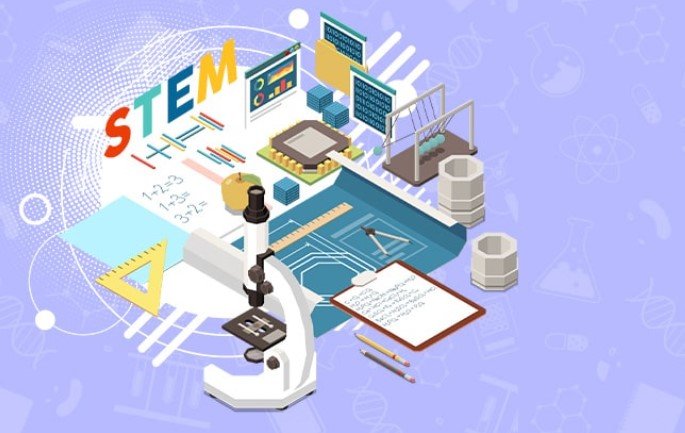Are you prepared for the future of technology and innovation? In today’s rapidly evolving world, STEM education holds the key to unlocking endless opportunities and driving groundbreaking discoveries. As Canada positions itself as a leader in technological advancements, understanding the importance of STEM education becomes paramount.
STEM education plays a crucial role in equipping the next generation with the necessary skills and knowledge to thrive in an increasingly tech-driven society. The demand for individuals proficient in science, technology, engineering, and mathematics is skyrocketing, shaping industries and revolutionizing how we live and work. Through active participation in STEM projects, students gain practical experience that fosters critical thinking, problem-solving abilities, and effective communication skills.

The Current Landscape of STEM Education in Canada
Shortage of Qualified STEM Professionals
Canada is currently facing a shortage of qualified professionals in the fields of Science, Technology, Engineering, and Mathematics (STEM). This scarcity poses a significant challenge to the country’s ability to remain competitive in an increasingly technology-driven global economy. With rapid advancements in technology and innovation, there is a growing demand for individuals skilled in STEM disciplines who can contribute to various sectors such as healthcare, engineering, computer science, and environmental sustainability.
Lack of Access to Quality STEM Education Opportunities
Unfortunately, many students across Canada lack access to quality STEM education opportunities. This disparity can be attributed to various factors such as limited resources in schools, inadequate teacher training in STEM subjects, and geographical barriers that restrict access to specialized programs or extracurricular activities. As a result, students from marginalized communities or remote areas often face additional challenges.
Efforts are being made by educational institutions, governments, and non-profit organizations to bridge this gap by providing equal opportunities for all students. Initiatives like coding workshops, robotics clubs, and mentorship programs aim to engage students early on and foster their interest in STEM subjects. By introducing interactive learning experiences and hands-on projects, these initiatives help cultivate critical thinking skills while nurturing creativity and problem-solving abilities.
Increasing Participation and Diversity in STEM Fields
In recent years, there has been a concerted effort to increase participation and diversity within the field of STEM. Recognizing the importance of representation and inclusivity, organizations are working towards breaking down barriers that prevent underrepresented groups from pursuing careers in these fields.
One approach involves promoting gender equality by encouraging more girls and women to pursue studies and careers in traditionally male-dominated areas such as engineering or computer science. Programs like Girls Who Code provide support networks where young women can explore their passion for technology while building confidence through mentorship opportunities.
Efforts are being made to increase the participation of Indigenous communities and other underrepresented groups in STEM fields. By incorporating Indigenous knowledge systems and perspectives into STEM curricula, educational institutions can create a more inclusive learning environment that values diverse ways of knowing and understanding the world.
Government-Led Initiatives Boosting STEM Education
Various Programs Promoting STEM Education
The Canadian government has taken proactive measures to promote STEM education across the country. Through national initiatives and funding programs, they aim to equip students with the necessary skills for the future of technology and innovation. These initiatives have been instrumental in fostering a culture of scientific inquiry and technological advancement among Canadian youth.

Funding Initiatives Supporting Innovative Teaching Methods
One key aspect of these government-led initiatives is the provision of financial support to schools and educators. The funding enables them to develop innovative teaching methods that engage students in hands-on learning experiences. By incorporating practical applications of STEM concepts, such as robotics or coding projects, educators can make the subject matter more tangible and relatable for students.
Enhancing STEM Learning Experiences through Collaboration
Collaboration between schools, industry partners, and government entities plays a crucial role in enhancing STEM education in Canada. By working together, these stakeholders can leverage their unique expertise and resources to create impactful learning opportunities for students. For example, partnerships between schools and local businesses allow students to gain real-world exposure to STEM careers through internships or mentorship programs.
National Initiatives Driving Progress
National initiatives like “CanCode” have been influential in driving progress in STEM education across Canada. This program provides funding for educational organizations to offer coding workshops and activities to both teachers and students. By equipping educators with coding skills and empowering them to integrate them into their curriculum, CanCode aims to ensure that all Canadian youth have access to quality computer science education.
Fostering Diversity and Inclusion in STEM
Another important aspect of government-led initiatives is their focus on fostering diversity and inclusion within the field of STEM. Recognizing the importance of representation, programs are being implemented to encourage underrepresented groups, such as women and Indigenous communities, to pursue careers in science, technology, engineering, and mathematics. By breaking down barriers and providing equal opportunities, these initiatives aim to create a more inclusive STEM workforce that reflects the diversity of Canadian society.
Exploring the Four Pillars of STEM Education
Science
Science is a fundamental pillar of STEM education, fostering curiosity and critical thinking skills among students. By engaging in scientific inquiry, students learn to ask questions, conduct experiments, and analyze data. This process encourages them to think analytically and develop a deeper understanding of the world around them.
Through hands-on activities and experiments, students explore various scientific concepts and phenomena. They learn how to formulate hypotheses, design experiments, and draw conclusions based on evidence. Science education equips students with the skills necessary to approach problems from a scientific perspective, enabling them to make informed decisions in their daily lives.
Technology
In today’s digital age, technology plays a vital role in our lives. STEM education places a strong emphasis on developing digital literacy and technological problem-solving abilities. Students learn how to navigate technology effectively while also gaining an understanding of its impact on society.
One key aspect of technology education is coding. By learning programming languages such as Python or Java, students acquire computational thinking skills that enable them to solve complex problems through logical reasoning. They gain an understanding of algorithms and how they can be used to optimize processes.
Furthermore, technology education focuses on teaching students about emerging technologies such as artificial intelligence (AI), robotics, and virtual reality (VR). By exploring these fields, students develop an awareness of the possibilities that technology holds for future innovation.
Engineering
Engineering is all about applying scientific principles to design solutions for real-world problems. STEM education encourages students to engage in hands-on activities that foster creativity and critical thinking through the application of engineering principles.
Students are introduced to the concept of design thinking – a human-centered approach that involves identifying challenges, brainstorming ideas, prototyping solutions, testing them out, and refining designs based on feedback. This iterative process helps cultivate problem-solving skills while encouraging collaboration among peers.
By engaging in engineering projects or challenges, students learn to think critically, analyze constraints, and develop innovative solutions. They gain practical skills in areas such as mechanical design, structural analysis, and electrical circuitry.
Mathematics
Mathematics forms the foundation of STEM education, developing analytical reasoning and logical thinking skills. Students learn to solve complex problems by applying mathematical concepts and techniques.
STEM education emphasizes the importance of mathematical proficiency across various disciplines. Students learn algebraic reasoning, geometry, statistics, and calculus. These mathematical skills enable them to analyze data, make predictions, and draw conclusions based on evidence.
Moreover, mathematics is integrated into other STEM subjects. For example, in science experiments or engineering projects, students use mathematical models to represent real-world phenomena or optimize designs.
Benefits of STEM Education for Canada’s Progress
Increased Economic Growth through Innovation and Entrepreneurship
STEM education plays a crucial role in driving economic growth in Canada by fostering innovation and entrepreneurship. With a strong foundation in science, technology, engineering, and mathematics, students are equipped with the skills necessary to develop groundbreaking ideas and create new technologies. This leads to the establishment of innovative startups and the expansion of existing industries.
Through STEM education, students learn how to think critically, analyze problems, and find creative solutions. These problem-solving skills are essential for entrepreneurs who need to identify market gaps and develop products or services that meet consumer needs. By encouraging an entrepreneurial mindset from an early age, STEM education cultivates a culture of innovation that fuels economic growth.
Enhanced Global Competitiveness by Producing Skilled Workers for Emerging Industries
In today’s rapidly evolving global landscape, countries must strive to remain competitive on an international level. STEM education plays a vital role in ensuring Canada’s global competitiveness by producing a skilled workforce ready to tackle emerging industries such as artificial intelligence, renewable energy, biotechnology, and more.
By providing students with a solid understanding of STEM disciplines, Canada can nurture talent that is well-equipped to contribute to these cutting-edge industries. The demand for professionals with expertise in science and technology continues to grow exponentially worldwide. Through comprehensive STEM education programs, Canada can position itself as a leader in these emerging fields while attracting investments from both domestic and international companies.
Improved Problem-Solving Abilities to Address Complex Societal Challenges
Societal challenges are becoming increasingly complex and require multidisciplinary approaches for effective solutions. STEM education equips students with the knowledge and skills necessary to address these challenges head-on. By integrating science, technology, engineering, and mathematics into their learning experiences, students gain a holistic understanding of real-world issues.
STEM education fosters critical thinking skills that enable students to analyze complex problems systematically. They learn how different disciplines can intersect and collaborate to find innovative solutions. For example, addressing climate change requires a multidisciplinary approach that combines scientific research, technological advancements, engineering solutions, and mathematical modeling.
By developing strong problem-solving abilities through STEM education, students are empowered to tackle pressing societal challenges such as sustainability, healthcare disparities, and urban planning. They become agents of change who can contribute meaningfully to the betterment of society.
Advancing Classroom Integration of STEM Concepts
Supporting Teachers with Professional Development Opportunities
To ensure the effective integration of STEM concepts in the classroom, it is crucial to support teachers with professional development opportunities. By providing educators with training and resources focused on effective pedagogical strategies for teaching STEM subjects, we can equip them with the necessary skills and knowledge to engage students in meaningful learning experiences. Workshops and seminars that emphasize innovative teaching methods, such as project-based learning and inquiry-based instruction, can empower teachers to create dynamic and interactive lessons that foster science literacy among their students.
Creating Engaging Hands-on Activities
One way to enhance STEM education is by creating engaging hands-on activities that connect real-world applications to classroom learning. These activities allow students to apply theoretical concepts in practical ways, fostering a deeper understanding of scientific principles. For example, designing and building a model bridge can help students grasp engineering principles while also developing critical thinking and problem-solving skills. By incorporating such activities into the curriculum, educators can make science education more relatable and enjoyable for students.
Promoting Collaborative Learning Environments
In addition to hands-on activities, promoting collaborative learning environments is essential for effective STEM education. Encouraging teamwork and collaboration among students not only enhances their social skills but also cultivates important problem-solving abilities. When working together on projects or experiments, students learn how to communicate effectively, delegate tasks, and brainstorm creative solutions. These collaborative experiences mirror real-life situations where individuals from different backgrounds must work together towards a common goal.
By creating an inclusive classroom environment that values diverse perspectives and encourages open dialogue, educators can foster an atmosphere where students feel comfortable asking questions and sharing their ideas without fear of judgment. This not only promotes a deeper understanding of scientific concepts but also helps combat science misinformation by encouraging critical thinking and evidence-based reasoning.
Addressing Challenges and Bridging Gaps in STEM
Encouraging Underrepresented Groups
Encouraging underrepresented groups, such as women and minorities, to pursue STEM careers is crucial for fostering diversity and inclusivity in the field. By actively promoting and supporting these individuals, we can tap into a wealth of untapped potential and bring fresh perspectives to the table. Organizations and educational institutions are taking steps to provide mentorship programs, scholarships, and outreach initiatives that inspire young girls and individuals from minority backgrounds to explore STEM fields. These efforts aim to break down barriers and empower underrepresented groups to pursue their passions in science, technology, engineering, and mathematics.
Providing Equal Access to Quality STEM Education
Ensuring equal access to quality STEM education across all regions of Canada is essential for nurturing talent nationwide. Disparities in resources or opportunities should not hinder students’ ability to engage with STEM subjects. Efforts are being made to bridge this gap through initiatives like online learning platforms, community-based programs, and partnerships between schools in different regions. By providing equitable access to educational resources, regardless of geographical location or socioeconomic background, we can create a level playing field where every student has an opportunity to excel in STEM.
Strengthening Partnerships between Academia, Industry, and Government
To bridge the skills gap in STEM fields effectively, it is crucial to foster strong partnerships between academia, industry, and government entities. Collaboration among these stakeholders allows for a better understanding of industry needs while ensuring that educational institutions align their curriculum with real-world demands. By working together closely, academia can provide students with relevant skills and knowledge needed by industries while also facilitating research collaborations that drive innovation forward. Furthermore, partnerships with government bodies help secure funding for research projects and create policies that support the growth of STEM education.
By addressing these challenges head-on and bridging gaps within the realm of STEM education in Canada, we can effectively prepare for the future of technology and innovation. Encouraging underrepresented groups, providing equal access to quality education, and fostering strong partnerships will create a thriving ecosystem that nurtures talent and drives advancements in STEM fields.
Looking Ahead: Emerging Trends in STEM Education
Integration of Emerging Technologies
As we prepare for the future of technology and innovation, it is crucial to integrate emerging technologies like artificial intelligence (AI) and virtual reality (VR) into STEM education. These technologies offer exciting opportunities to enhance the learning experience and equip students with the skills needed for tomorrow’s workforce. By incorporating AI and VR into the curriculum, students can explore complex scientific concepts in a more immersive and interactive manner. They can simulate experiments, analyze data, and solve real-world problems using these cutting-edge technologies.
Interdisciplinary Projects
Another emerging trend in STEM education is a focus on interdisciplinary projects that combine multiple STEM disciplines. Traditionally, subjects like science, technology, engineering, and mathematics were taught as separate entities. However, the world we live in today demands a more holistic approach to problem-solving. By encouraging students to work on interdisciplinary projects, they learn how different STEM fields intersect and complement each other. For example, students might collaborate on designing sustainable cities by applying principles from engineering, environmental science, computer programming, and mathematics.
Emphasis on Soft Skills Development
In addition to technical knowledge, there is an increased emphasis on developing soft skills alongside STEM education. Soft skills such as critical thinking, communication, collaboration, creativity, and adaptability are essential for success in any field. Employers are increasingly recognizing the importance of these skills when hiring candidates for STEM-related positions. By incorporating activities that foster teamwork and communication into the curriculum, educators can help students develop these vital skills alongside their technical expertise.
By embracing these emerging trends in STEM education—integrating emerging technologies like AI and VR into the curriculum; promoting interdisciplinary projects; and emphasizing soft skills development—we can better prepare students for the future of technology and innovation. This forward-thinking approach equips them with both the technical knowledge required for STEM fields as well as the critical thinking abilities necessary to navigate an ever-changing world. As we continue to adapt and evolve our education systems, it is crucial to stay abreast of these trends and ensure that our students are well-equipped to thrive in the future.
Conclusion
In conclusion, STEM education in Canada is crucial for preparing the future generation for the rapidly evolving landscape of technology and innovation. Through government-led initiatives and the integration of STEM concepts in classrooms, Canada has made significant strides in promoting STEM education. The four pillars of STEM education – science, technology, engineering, and mathematics – offer numerous benefits for Canada’s progress, from fostering critical thinking and problem-solving skills to promoting creativity and innovation.
To ensure continued success in STEM education, it is essential to address the challenges and bridge gaps that exist in this field. By investing in teacher training programs, providing equal opportunities for underrepresented groups, and encouraging collaboration between industry and academia, Canada can further strengthen its STEM education ecosystem. As emerging trends like virtual reality, artificial intelligence, and data analytics continue to shape the future, educators, policymakers, and stakeholders must stay informed and adapt their approaches accordingly.
By embracing STEM education and empowering students with the necessary skills and knowledge, Canada can secure its position as a global leader in technology and innovation. So why wait? Start exploring the exciting world of STEM today and join the journey towards a brighter future.
Frequently Asked Questions
[faq-schema id=”3159″]






